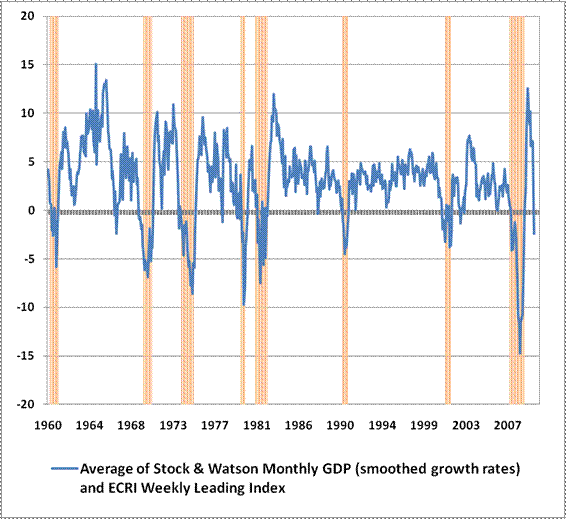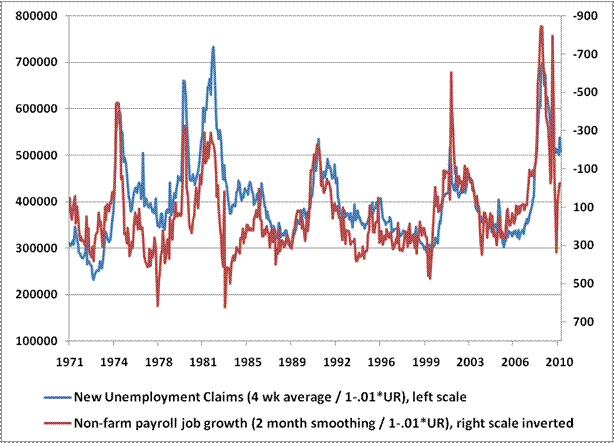By John P. Hussman, Ph.D. | 29 September 2010
All rights reserved and actively enforced.
In its release, the National Bureau of Economic Research noted that it "places particular emphasis on measures that refer to the total economy rather than to particular sectors". These include "a measure of monthly GDP that has been developed by the private forecasting firm Macroeconomic Advisers," and "measures of monthly GDP and GDI that have been developed by two members of the committee in independent research (James Stock and Mark Watson)". The Committee generously provides downloadable data on these measures, which make for fascinating research. In particular, a review of that data suggests that the NBER may have to deal with the prospect of a "future downturn of the economy" much sooner than any of us would like.
Below, I've combined the long-term Stock and Watson data with the ECRI Weekly Leading Index growth rate to give a picture of how fluctuations in these measures have correlated with past recessions (shaded orange) identified by the NBER. Given the upward spike in growth that we observed in mid-2009, the choice of a June 2009 turning point is consistent with historical precedent. The Committee typically dates the beginning of a recovery at the point where the growth rates of underlying measures of economic growth clearly spike from negative to positive. What is of immediate concern though, is the trajectory that growth rates have taken since then.

Again, the graph presented here is as of June 30, 2010. While we know the ECRI data has deteriorated further since June, we won't have GDP figures for a while yet. Given the data in hand, it's clear that past growth downturns of the same extent have often gone on to become recessions.
However, there are a few exceptions where these growth rates dipped below zero and then recovered. If we had good reason to expect positive economic tailwinds, we would be less concerned about the present deterioration. Unfortunately, my impression is that the bulk of the growth that we did observe coming off of the June 2009 economic low was driven by a burst of stimulus spending coupled with a variety of programs [which acted] to pull economic activity forward. My concern is that these synthetic factors are now trailing off, with little intrinsic economic activity to carry a recovery forward.
Suffice it to say that we're not yet out of the woods.
Employment Growth Versus GDP Growth
One clue about possible GDP growth can be obtained by looking at employment growth, since the two are clearly related. On a quarterly (non-annualized) basis, the average quarterly change in non-farm payrolls since 1960 has been about 0.4% (standard deviation +/— 0.6), while the average quarterly change in real GDP has been about 0.8% (standard deviation +/— 0.9). As of the August employment report, non-farm payroll growth over the past 3 months has been about -0.2%, or about 1 standard deviation below the norm.
This would correlate to a quarterly GDP loss of about -0.4%, or roughly -1.6% on an annualized basis. Of course, part of that employment loss was during June, so if we get 100,000 new jobs in the September employment report, the quarterly change will also be roughly flat, making it a coin flip as to whether third-quarter GDP was positive or negative. Unfortunately, the high rate of new claims for unemployment suggests continued pressure on the job market.
The 4-week average of new claims is presently at 459,500 weekly, which already would be associated with payroll job losses. But it is important to recognize that these job losses are on an already depressed labor force. To put the figures on an equal footing with historical data, one can place the data in the context of a fully employed labor force, by dividing by (1-.01 x unemployment rate). Admittedly, the current data would be even worse if we fully adjusted by using the U6 unemployment rate, which includes discouraged workers, but using the overall employment rate is sufficient to improve the statistical usefulness of the new claims data.
The chart below presents the historical relationship between the adjusted weekly new claims data and adjusted monthly non-farm payroll job growth. Note that the present rate of new claims would typically be consistent with roughly 250,000 monthly job losses on an adjusted basis, which works out to about 226,000 job losses given the present rate of unemployment. Fortunately, there have been other instances where job losses were thankfully much less than implied by the new claims data, but it is clear that the persistently high level of weekly new unemployment claims is inconsistent with the expectation of robust payroll gains.

Frankly, I am hoping that we are wrong on this. Our investment strategy is a long term one. We don't rely on being "right" about individual instances. Rather, we focus on average outcomes, taking greater exposure to risk in conditions that have historically been associated with favorable returns and taking less risk in conditions that have historically been associated with weak returns— on average.
The present overall return-to-risk profile is not favorable, on average. But again, despite our present defensive position, we would prefer— hands down— to be wrong about oncoming economic weakness. In our view the market is already fully priced for an economic recovery anyway, so the challenges are steep for investors even without a further downturn. As I've noted before, risk management is forgiving.
During the past decade of rich valuations, and based on our analysis, throughout history, the temporary returns that investors have missed during periods of hostile valuations and overbought conditions have been more than compensated by the avoidance of subsequent— often profound— losses that correct those valuations. But this is a long term, average tendency. We aren't market timers— we are risk managers. For now, conditions continue to stack on the defensive side.
ߧ
Normxxx
______________
The contents of any third-party letters/reports above do not necessarily reflect the opinions or viewpoint of normxxx. They are provided for informational/educational purposes only.
The content of any message or post by normxxx anywhere on this site is not to be construed as constituting market or investment advice. Such is intended for educational purposes only. Individuals should always consult with their own advisors for specific investment advice.
No comments:
Post a Comment